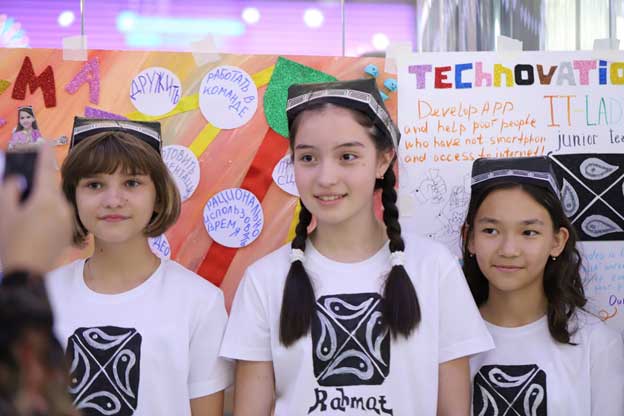Day of the Girl Child: A Digital Generation Where Every Girl Counts

NEW YORK, Oct 11 (IPS) - The theme of this year’s annual International Day of the Girl Child, on October 11, “Digital generation. Our generation.”, recognizes the digital transformation brought about by the COVID-19 pandemic. But while the pandemic accelerated the transition to online learning, working and networking, it also accelerated women and girl's risk of being left behind.
In 2020, more than 60 million women in Europe and Central Asia (ECA) had no access to the mobile internet and so, were more likely than men to miss out on learning and working opportunities.
Access, ownership and use of digital tools are not gender-neutral: For instance, parents may be stricter with girls than boys in the use of mobile phones and activities that require the use of the internet, while households with limited computing resources might redirect these to boys and men over girls and women, often tasked with domestic chores and unpaid work. Factors such as affordability and cost also affect women and girls disproportionally.
Moreover, social norms, gender bias and a lack of support from the family and teachers often dissuade girls and women from choosing education programmes in Science, Technology, Engineering and Mathematics (STEM) and from pursuing careers in these fields.

In Bosnia and Herzegovina, one in three girls report being discouraged by their families from choosing STEM subjects more broadly at university, while in Ukraine 23 percent of women aged 15-24 report a lack of self-confidence as the main reason for not pursuing a career in technology. With fewer women pursuing STEM fields, the scarcity of women role models for the younger generation persists, reinforcing the problem.
Gender equality in STEM
We must all join forces to advance gender equality in STEM. Measures include removing gender stereotypes in education, raising awareness and promoting STEM subjects to girls and women, and offering career guidance to encourage girls to consider studying in fields dominated by men.
Our regional advocacy platform, STEM4All, is engaging with multiple partners – from policymakers and academic institutions to women and girls themselves– in sharing knowledge, building coalitions and making connections to advance gender equality in STEM.
Earlier this year, the platform facilitated a 'Girls in Tech: Central Asia' event, which brought together leaders from the tech industry and ICT role models to share experiences and offer advice to more than 120 girls and women in Kazakhstan, Kyrgyzstan, Tajikistan, Turkmenistan, and Uzbekistan.
One of our goals in the platform is to profile high-impact initiatives by our partners, government, and the private sector. For instance, the Engineer Girls of Turkey project is a wonderful model of how we can increase the employability of qualified women in engineering with scholarships, internships and mentoring, and coaching support.
In Azerbaijan, UNDP has partnered with USAID in piloting a nine-month mentorship programme to equip young women and girls with tools and advice to progress in STEM fields. The platform is powered by the Accelerator Labs, a UNDP learning network created to accelerate progress towards the achievement of the Sustainable Development Goals.
The Future of work
While the demand for workers in STEM occupations is only expected to grow in the future, in Europe and Central Asia, the share of women researchers in engineering and technology crosses 40 percent only in a few countries. The number of women in computer science is also particularly low compared to men: women are only 18 percent of ICT specialists in the EU, while just 16 percent of founders in the ICT and tech fields in Southern Caucasus and Western CIS are women.
Cultural and social norms, a lack of childcare support, and inadequate parental leave policies are major barriers to women entering and progressing in careers of their choice. These obstacles are amplified manifold in STEM fields, whose men-dominated workplaces and entrenched gender stereotypes present formidable impediments for many talented women.
Gender equality in STEM and in the future of work is a goal unto itself. We cannot deny half of humanity the opportunity to enter and succeed in this high-growth sector which powers the green and digital transition.
But there are also compelling economic and social reasons for us to strive towards this goal.
In the EU, for example, closing the gender gap in STEM could lead to an additional 1.2 million jobs. More women graduating in STEM subjects and choosing careers in higher-wage sectors can gradually increase their average earnings, helping to close the gender wage gap.
The world and the future of work need women's skills and perspectives, talent and leadership, as much as those of men. This requires all our concerted actions to close the gender digital gap and leverage the power of technology to advance girls’ and women’s education, leadership and equal future.
Mirjana Spoljaric Egger is Assistant Secretary-General of the United Nations, Assistant Administrator of UNDP, and Director of the UNDP Regional Bureau for Europe and the CIS. She was appointed to this position by the Secretary-General of the United Nations in August 2018 and assumed her duties in October 2018.
Follow @IPSNewsUNBureau
Follow IPS News UN Bureau on Instagram
© Inter Press Service (2021) — All Rights Reserved. Original source: Inter Press Service
 Global Issues
Global Issues